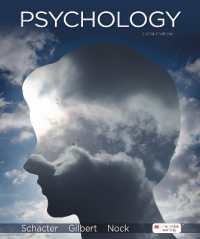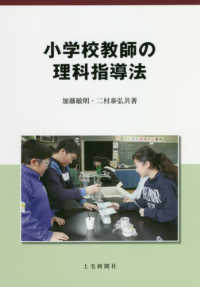- ホーム
- > 洋書
- > 英文書
- > Science / Mathematics
Full Description
This edited book addresses a gap in literature by advancing current understandings of the applications of immersive technology within the architecture, engineering and construction (AEC) sector.
Globally, the architecture, engineering and construction (AEC) sector makes an enormous contribution to the socio-economic development of nations, which is primarily evidenced by its creation/provision of the built environment. The sector has, however, often been criticised for inefficiencies, waste and diverse forms of adverse impacts that are associated with the lifecycle of the provision of built assets - design, construction, operations and maintenance and end-of-life phases. Over the years, the inefficiencies, waste and adverse impacts have often been a catalyst for calls and initiatives to transform the AEC sector. The advent of the fourth industrial revolution (commonly referred to as, 'Industry 4.0'), which entails the automation and digitalisation of production, presents opportunities to leverage emerging technologies to improve the image and productivity of the sector. Prominent among the emerging technologies in the Industry 4.0 era is that of immersive technology, which includes virtual reality, mixed reality and augmented reality. The capability of immersive technology to deliver beneficial impacts for multiple construction sector stakeholders throughout the construction lifecycle has been acknowledged within the industry and this continues to stimulate interest amongst practitioners, policymakers and researchers. Despite this phenomenon, at present there is no dedicated compendium of research-informed text that focusses on the multifaceted applications of immersive technology throughout the lifecycle of the provision of built assets right from concept design to end-of-life.
This book thus addresses this gap in literature by advancing current understanding of the applications of immersive technology within the AEC industry. Readers will understand how the technologies are applied, the resulting array of impacts including benefits, drawbacks, challenges and future directions for applications, research and development.
Contents
1. Applications of Immersive Technology in Architecture, Engineering and Construction: An Introduction. 2. Application of Immersive Technologies in the Management of Brownfield Sites: Current Perspectives and Future Prospects. 3. Navigating Urban Futures: Crafting An Experimental Framework For Eye-Tracking Integrated Virtual Reality In Co-Creative Planning. 4. Virtual Reality Technology in Architectural Psychology Learning: Design for Autism as a Case Study. 5. Virtual Reality Simulation of Pedestrian Evacuation in Earthquake Scenarios: Informing Urban Design for Enhanced Evacuation. 6. A Virtual Reality Approach to Enhancing Hazard Perception in Construction Using Eye-Tracking and Deep Learning. 7. Applications of Immersive Technologies in Investigating Construction Workers' Risk-Taking Behaviors at Individual and Team Levels. 8. Applications of Immersive Technology in Building Construction Phase: Fostering Sustainability in the Global Context. 9. Augmented Reality Assisted Inspection for Construction Practice and Education. 10. Immersive Emergency Preparedness: Enhancing Tunnel Operations with Virtual Reality Door Closure Training. 11. Immersive Technology in Construction Planning and Scenario Evaluation. 12. Characterising Research on AR and VR for Health and Safety Training of Onsite Construction Workers: Identifying Gaps and Future Directions in Research. 13. New Approaches Towards Disasters in the Built Environment: Risk Communication and Training Through Virtual Reality. 14. Integration of Immersive Technology and Digital Twins for Emergency Management in Buildings: A Systematic Literature Review. 15. Enhancing the recovery process for Historic Buildings Through Virtual Environments Based on Panoramas Integrated with Informative System. 16. Virtual Reality (VR) Application for Exploring Earthship Houses for Second-Time House Buyers in the UK. 17. General Public's Perception of Earthship Buildings in the UK: An Immersive VR Based Approach. 18. Advancing Knowledge and Fostering Connections for Networks of Historical Assets Through Informative Systems and Virtual Reality. 19. Agents' Perceptions of the Potential Use of Virtual Reality in Sales of Residential Real Estate. 20. A Proposed Methodology for Developing Immersive Technological Tools for Occupational Safety and Health Training and Education in the Construction Industry. 21. An Overview of Technical Requirements and Considerations for Mixed Reality-Bim Adoption in Online Construction Management Education. 22. An Investigation of the Potential Benefits of Gamification in the Nigerian Construction Industry. 23. Air Pollution Around Schools - AEC and Immersive Technology. 24. Towards a Metaverse Platform for Immersive Collaborative Design: A Critical Review of a Furniture, Fixture and Equipment (FFE) Application.








